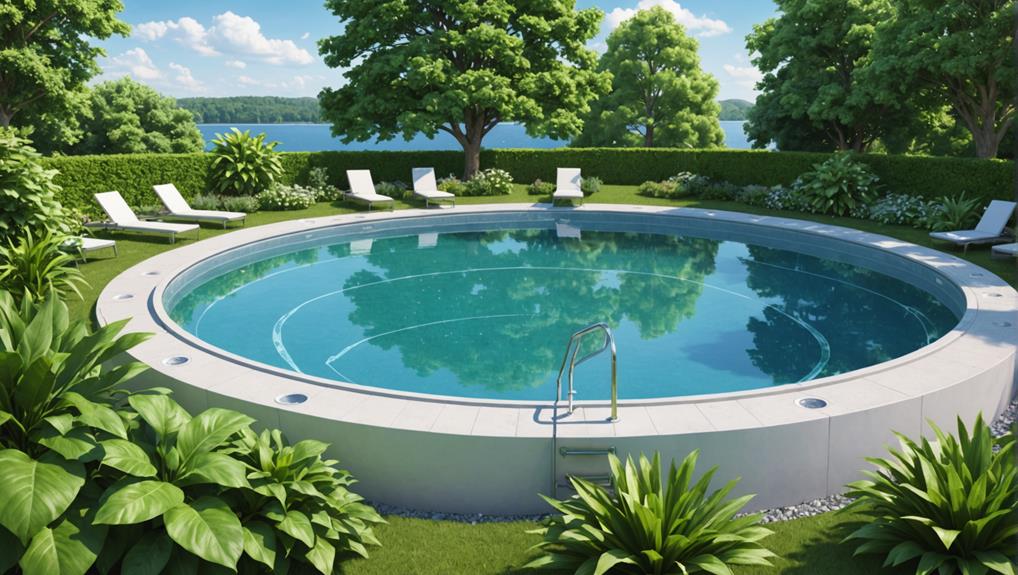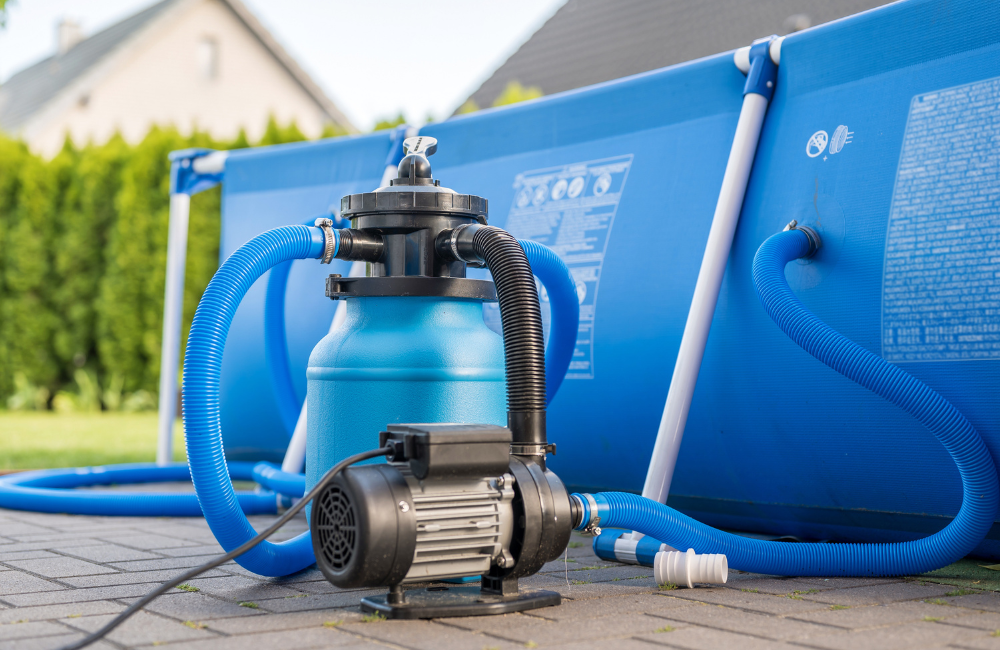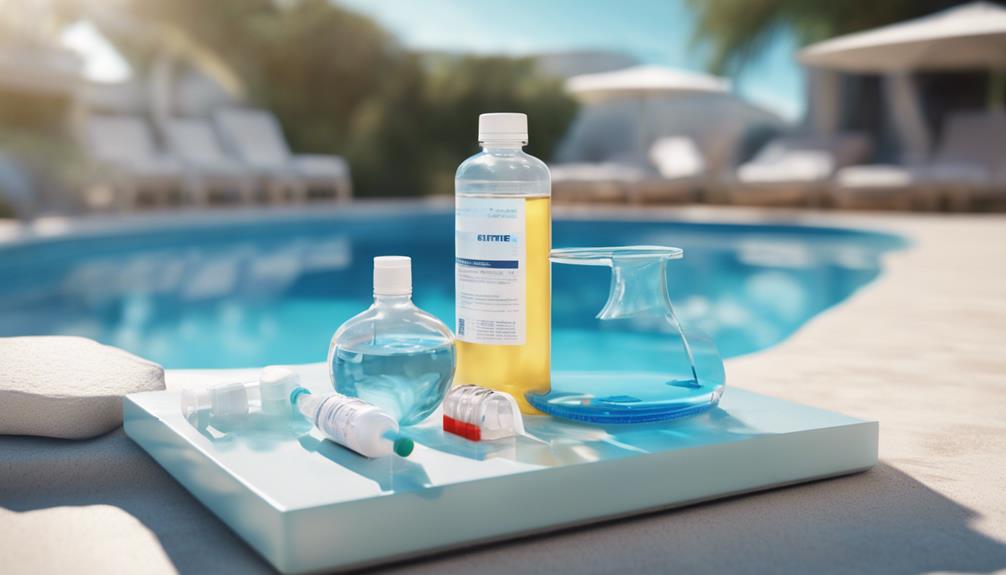You can prevent algae growth in your pool by mastering seven essential chemical balance methods. First, monitor and adjust pH levels to maintain a stable environment. Next, control chlorine and cyanuric acid levels to inhibit algae formation. Balance calcium hardness and alkalinity to facilitate proper sanitizer efficiency. Manage phosphates and nitrates to prevent their negative impact on pool balance. Maintain proper filtration and circulation to remove dirt and debris. Shock your pool regularly to remove contaminants. Finally, regularly test and balance water chemistry to stay on top of potential issues. By following these steps, you’ll be well on your way to a balanced and algae-free pool environment.
Key Takeaways
- Regularly test and adjust pH levels to maintain a stable chemical balance, preventing algae growth and inefficiencies.
- Maintain ideal levels of chlorine (1-3 ppm) and cyanuric acid (30-50 ppm) to inhibit algae formation and promote healthy pool water chemistry.
- Balance calcium hardness (200-400 ppm) and alkalinity (80-120 ppm) levels to prevent algae growth and ensure proper sanitizer efficiency.
- Manage phosphate and nitrate levels through regular testing and use of phosphate removers to prevent algae growth and imbalance.
- Perform regular shock treatments and maintain consistent chlorine levels to prevent algae blooms and ensure a safe, clean, and balanced pool environment.
Monitor and Adjust Ph Levels
To guarantee ideal chemical reactions and prevent unwanted side effects, you must regularly monitor the pH levels of your reactants and adjust them as necessary to maintain a stable chemical balance.
pH levels that are too high or too low can disrupt the chemical reactions, leading to inefficiencies and potential harm to your pool or spa.
To balance your water, you need to test the pH levels regularly using a reliable test kit.
This kit will provide you with accurate readings, allowing you to make informed decisions about adjustments.
If the pH levels are off, you can adjust them by adding pH increasers or decreasers as necessary.
Remember that pH levels can fluctuate over time, so regular monitoring is vital.
Control Chlorine and Cyanuric Acid
By maintaining ideal levels of chlorine and cyanuric acid, you guarantee a balanced environment that prevents algae growth and promotes healthy pool water chemistry.
To achieve this, you must monitor and adjust these levels regularly.
Maintain a chlorine level of 1-3 ppm, as this inhibits the formation of chloramines that can contribute to algae blooms.
Keep cyanuric acid levels between 30-50 ppm, ensuring chlorine remains effective against algae.
Regularly test and adjust chlorine and CYA levels to maintain a balanced environment, as this is crucial for preventing algae growth.
Be mindful of chlorine tablet usage, as they can increase CYA levels over time, and consider shocking the pool weekly to maintain a healthy chlorine level and prevent algae growth.
Balance Calcium Hardness and Alkalinity

Maintaining a delicate balance between calcium hardness and alkalinity is essential for preventing algae growth and ensuring proper sanitizer efficiency in your pool. You should aim to keep calcium hardness levels between 200-400 parts per million (ppm) and alkalinity levels between 80-120 ppm. This balance is crucial, as low levels of either can lead to ineffective sanitizing and increased risk of algae growth.
Here’s a breakdown of the ideal levels for calcium hardness and alkalinity:
| Parameter | Ideal Level | Effect of Imbalance |
|---|---|---|
| Calcium Hardness | 200-400 ppm | Low levels: algae growth, ineffective sanitizing |
| Alkalinity | 80-120 ppm | Low levels: pH fluctuations, algae growth |
| Balance | Calcium Hardness:Alkalinity = 2:1 | Imbalance: ineffective sanitizing, algae growth |
To achieve this balance, you’ll need to regularly test your pool’s calcium hardness and alkalinity levels. Make adjustments gradually to prevent sudden changes that can lead to algae growth or other pool imbalances. By maintaining the right balance, you’ll create an environment that’s hostile to algae growth and optimal for sanitizer efficiency.
Manage Phosphates and Nitrates
You’ll also need to monitor and control phosphate and nitrate levels, as these nutrients can fuel algae growth and negatively impact your pool’s overall balance and sanitizer effectiveness.
Phosphates, in particular, are a primary food source for algae, and even small amounts can trigger an outbreak. To prevent this, consider using a phosphate remover to eliminate excess phosphates from your pool water.
Regularly test your pool water for phosphate and nitrate levels to catch any imbalances early.
Use a phosphate remover to eliminate excess phosphates and prevent algae growth.
Maintain a balanced nitrogen and phosphorus ratio, as an imbalance can fuel algae growth.
Perform regular water changes to remove built-up phosphates and nitrates, and prevent algae prevention.
Maintain Proper Filtration and Circulation
Proper filtration and circulation are essential to removing dirt, debris, and contaminants from your pool water, maintaining a safe and healthy swimming environment.
To maintain proper filtration, you should run your pool filter continuously, 24/7, to capture suspended particles and algae. Make sure to clean or replace your filter elements as recommended by the manufacturer to guarantee peak performance. Additionally, backwash your filter regularly to remove accumulated debris and prevent channeling.

Effective circulation is equally important, as it helps to distribute sanitizers and other chemicals evenly throughout the pool. Verify that your pool’s circulation system is functioning correctly, and consider upgrading to a variable-speed pump if your current one is inefficient.
You should also confirm that your pool’s return jets are adjusted properly to create a gentle, clockwise circulation pattern. By maintaining proper filtration and circulation, you’ll be able to remove contaminants and prevent algae growth, keeping your pool water clean, clear, and safe for swimmers.
Regularly inspect your pool’s filtration and circulation systems to confirm they’re working efficiently and effectively.
Shock the Pool to Remove Contaminants
When your pool’s filtration and circulation systems are running efficiently, it’s time to shock the pool to remove contaminants and oxidize any built-up pollutants.
Shocking your pool with calcium hypochlorite shock treatment can super-chlorinate the water and kill algae growth by oxidizing any built-up contaminants.
To facilitate effective shock treatment, follow these steps:
- Remove everything from the pool except cleaning equipment to prevent any interference with the shock treatment process.
- Run the filter continuously for a minimum of 8 hours to circulate the shock treatment and allow it to reach all areas of the pool.
- Clean or backwash the filter after shocking the pool to remove any dead algae particles and prevent them from re-circulating into the pool water.
- Shock your pool regularly, ideally once a week during peak pool season, to maintain a clean and balanced pool environment.
Regularly Test and Balance Water Chemistry

As you work to maintain ideal water chemistry, you’ll need to regularly test and balance three key components: pH levels, chlorine levels, and calcium hardness.
By monitoring these factors, you’ll be able to identify and correct any imbalances that could lead to algae growth or other issues.
Monitor Ph Levels
You must test pH levels regularly to maintain the water chemistry remains within suitable ranges, as even slight deviations can have significant consequences.
pH levels that are too high or too low can affect the effectiveness of other chemical levels, leading to an imbalance in your pool water.
To ensure optimal chemical balance, you should test pH levels:
At least once a week: Regular testing helps you detect any changes in pH levels and make necessary adjustments.
After heavy rainfall or storms: Inclement weather can alter pH levels, so it’s essential to test after such events.
After adding chemicals: Chemical additions can affect pH levels, so test after adding any chemicals to your pool water.
When you notice changes in pool water clarity or algae growth: If you notice any changes in your pool water, test pH levels to identify potential causes.
Check Chlorine Levels
Maintaining a consistent chlorine level is critical to preventing algae growth and ensuring the water remains safe and clean for swimmers.
As you test and balance your water chemistry, you should prioritize checking chlorine levels daily, or at least every other day. This frequency helps you catch any imbalances before they lead to algae growth, cloudy water, or eye irritation.
Aim to maintain chlorine levels between 1-3 parts per million (ppm) to effectively sanitize the water and prevent algae growth. You can use automatic chlorine feeders or liquid chlorine to maintain consistent chlorine levels.
By doing so, you’ll create an environment that’s hostile to algae growth. Remember, regular testing and balancing are essential to preventing algae blooms.
Don’t underestimate the importance of consistent chlorine levels in your water chemistry. By staying on top of your chlorine levels, you’ll be well on your way to a safe, clean, and algae-free pool.
Balance Calcium Hardness
Now that chlorine levels are under control, it’s time to shift focus to another vital aspect of water chemistry: calcium hardness. Maintaining the right balance of calcium hardness is essential to preventing algae growth and proper sanitizer efficiency.
Aim to maintain calcium hardness levels between 200-400 parts per million (ppm) to prevent algae growth and facilitate proper sanitizer efficiency.
Regular testing is vital, as low levels can lead to algae blooms, while high levels can cause scaling and cloudiness in the water.
Calcium hardness can be increased by adding calcium chloride or calcium carbonate to the pool water, but be sure to follow the manufacturer’s instructions to avoid over-correction.
Failure to maintain proper calcium hardness levels can result in etching of the pool surface, leading to costly repairs and replacements.
Frequently Asked Questions
What Is the Best Method of Algae Prevention?
You’ll find that the best method of algae prevention involves a multi-faceted approach, including regular maintenance to disrupt algae life cycles, effective water circulation to prevent stagnation, and natural barriers like phosphate removers to starve algae of essential nutrients.
What Chemical Prevents Algae?
You’re the captain of your aquatic ecosystem, steering clear of algae invasions. To prevent algae, you’ll find that chlorine, bromine, and algaecides like copper-based products are effective algae inhibitors, triggering chemical reactions that disrupt algae growth, ensuring a balanced and thriving aquatic environment.
What Is the Chemical Generally Used for Controlling Algae?
You’ll typically use algaecides like copper-based products, quaternary ammonium compounds, or bromine to control algae, as they trigger chemical reactions that inhibit growth; however, it’s essential to conduct regular water testing to determine the most effective type and dosage for your specific situation.
What Ph Level Prevents Algae?
You maintain ideal water clarity by targeting a pH range of 6.5-8.5, as this prevents algae growth by limiting nutrient availability, staying below the algae threshold of 9.0, where rapid proliferation occurs.
Conclusion
You’ve implemented the 7 best chemical balance methods to prevent algae. By doing so, you’ve substantially reduced the risk of those pesky green blooms ruining your pool experience.
Did you know that the average pool owner spends around $1,500 annually on chemicals and maintenance?
By following these methods, you can save a substantial amount of that budget and enjoy a cleaner, healthier pool all season long.

I’m Max, the founder and chief pool enthusiast behind Pool Pro Tips. As a passionate pool owner and cleaning expert, I created this website to share my knowledge and experience with you, helping you to keep your pool sparkling clean and safe for years to come.

